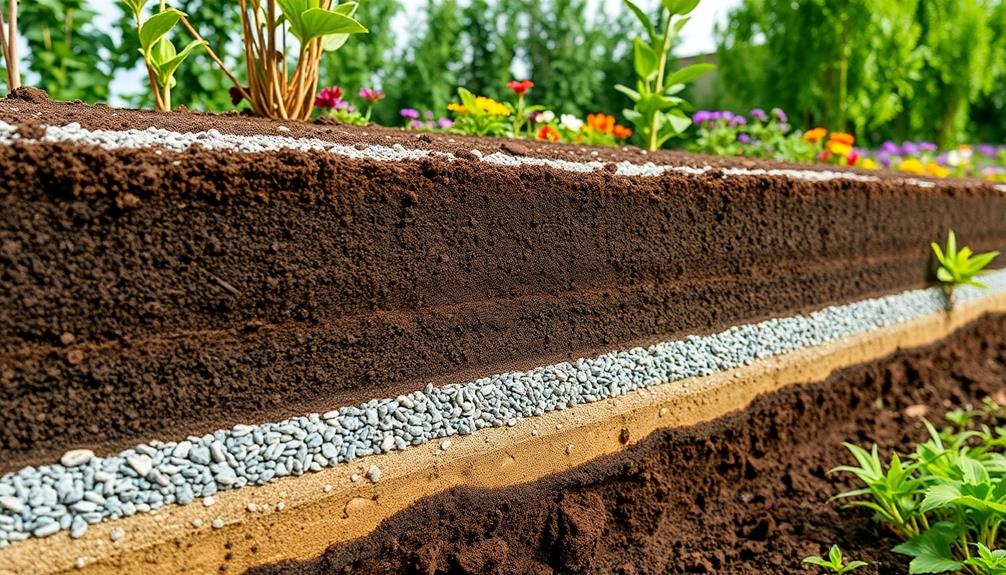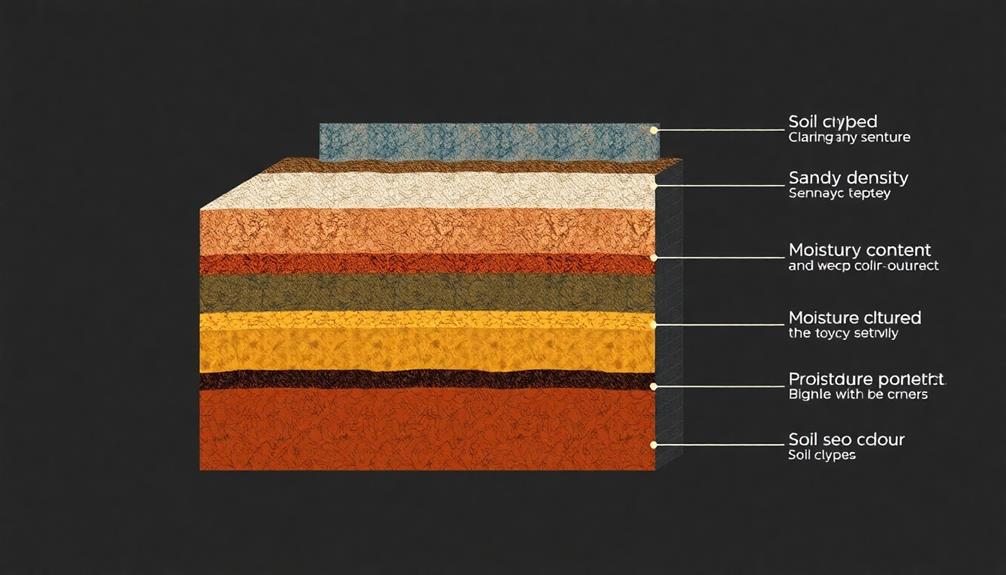Soil mechanics is critical for retaining walls as it governs the interaction between soil properties and structural stability. Understanding the principles of soil behavior, such as load-bearing capacity, compressibility, and shear strength, is essential in assessing how these properties change under varying conditions like moisture content and compaction. Comprehensive soil analysis discloses optimal load distribution and drainage, preventing issues like erosion and hydrostatic pressure that compromise wall integrity. The ability to predict soil movements and adapt design strategies accordingly safeguards against structural failure and enhances the longevity of retaining structures. Investigating further reveals the nuanced benefits of adept soil-structure integration.
Table of Contents
ToggleWalls Contractor Highlights
- Soil mechanics provides essential insights for assessing the load-bearing capacity critical to retaining wall stability.
- Understanding soil behavior under different conditions helps predict and prevent potential structural failures.
- Evaluating soil-structure interactions ensures precise modeling for long-term retaining wall performance.
- Accurate soil analysis informs drainage solutions, mitigating risks of water-related damage to retaining walls.
- Tailored engineering strategies based on soil characteristics optimize retaining wall design and resource use.
Definition of Soil Mechanics

Soil mechanics is a vital branch of civil engineering that addresses the principles of soil behavior and their interactions with structural entities, playing a pivotal role in the design and stability of retaining walls. Understanding the interactions between soil layers and construction materials is essential for predicting changes in soil conditions and ensuring the durability and safety of infrastructure.
Companies like Boulder Walls utilize this knowledge to provide high-quality retaining walls that can withstand various weather conditions and meet building code requirements. This discipline is indispensable for construction projects as it provides the foundational knowledge required to mitigate risks associated with soil-related failures and enhance the longevity of built environments.
Principles of Soil Behavior
Understanding the principles of soil behavior is fundamental in the field of soil mechanics, especially in designing effective retaining walls. Soils, unlike other structural materials, are complex and heterogeneous, their behavior influenced by myriad factors including particle size, shape, water content, and mineral composition.
The engineering analysis of soil behavior encompasses both the external forces exerted upon it and its intrinsic properties, which may vary dramatically even over small areas. It is essential for engineers to evaluate how these properties can alter under diverse conditions, such as saturation, compaction, and shear.
In retaining wall design, the key principles include understanding soil's load-bearing capacity, compressibility, and shear strength. Load-bearing capacity refers to the soil's ability to support loads without failing, while compressibility involves how much a soil sample can compact under pressure, affecting wall settlement. Shear strength is the maximum stress the soil can withstand before failing, vital for determining stability and resistance to sliding. Each of these characteristics informs the design choices that guarantee the longevity and safety of retaining walls. As a result, a robust comprehension of soil behavior safeguards infrastructure against the inherent unpredictability of soil as a geological material.
Soil Structure Interactions
In addition to the principles of soil behavior, the study of soil mechanics encompasses the complex interactions between soil and structures, particularly significant in the context of retaining walls. Soil-structure interactions are crucial to comprehending how forces are transferred between a retaining wall and the soil it supports.
This relationship involves intricate dynamics, where soil exerts pressure on the retaining wall due to gravitational forces, shear strength, and cohesion properties. Such interactions require detailed analysis to guarantee the wall's stability and performance over time.
Retaining walls must be designed with a thorough understanding of these interactions to effectively resist lateral earth pressures. Engineers must account for factors like soil type, moisture content, density, and load conditions that influence the behavior of both the soil and the structure.
Moreover, the interface between the wall and the soil may experience distinct stress patterns, necessitating precise modeling to avoid structural failure. Such precision in design fosters a sense of confidence and security among communities relying on these structures to protect infrastructures, manage erosion, and maintain landscapes.
The robustness of retaining walls is thus inherently linked to the sophisticated interplay of soil-structure interactions, integral to confirming their functionality and safety.
Importance in Construction Projects
Integral to the success of construction projects, soil mechanics plays a pivotal role in evaluating site conditions and predicting how soils will behave under varying loads. This scientific study explores the characteristics of soils, such as strength, permeability, and compressibility, thereby guiding engineers and architects in making informed decisions. When constructing retaining walls, understanding these soil properties is indispensable, as they directly influence stability and safety.
To appreciate the importance of soil mechanics in construction projects, consider the following:
- Site-specific soil analysis: Guarantees that the foundation design aligns seamlessly with the site's unique characteristics, promoting structural integrity.
- Load-bearing capacity assessment: Evaluates the soil's ability to support structural loads, preventing undue settlement or failure.
- Drainage and erosion control: Facilitates ideal water management, reducing the risk of soil erosion and hydrostatic pressure buildup.
Benefits

The application of soil mechanics in the design of retaining walls offers significant benefits, primarily in enhancing structural stability and increasing the overall durability and lifespan of these indispensable infrastructures. By ensuring ideal load distribution and understanding soil properties, engineers can implement cost-effective construction practices that not only maintain safety standards but also reduce long-term maintenance expenses. This strategic approach underscores the importance of integrating soil mechanics principles to maximize the efficiency and dependability of retaining wall projects.
Retaining wall repair expertise plays a pivotal role in maintaining the structural integrity and safety of existing walls, ensuring they continue to perform their intended function effectively. Proper soil mechanics consideration also contributes to the aesthetic appeal of retaining walls, allowing for versatile design options that complement the surrounding landscape.
Enhanced Structural Stability
Retaining walls play an essential role in ensuring enhanced structural stability by effectively resisting lateral earth pressures. This structural reinforcement is paramount in scenarios where soil must be stabilized on uneven terrain or where slopes require support to prevent landslides. Engineering these walls with a clear grasp of soil mechanics is indispensable, as it aids in determining suitable wall type, material strength, and foundation depth.
For communities nestled in hilly landscapes, these insights foster a profound sense of safety and cohesion, knowing that their shared environment is secure.
The benefits of employing soil mechanics in retaining wall design include:
- Optimized Load Distribution: By analyzing soil properties, engineers can design walls that evenly distribute the load, preventing failure due to localized stress.
- Enhanced Pressure Resistance: Detailed understanding of lateral earth pressures allows for superior design capabilities to withstand the forces exerted by retained soil.
- Ground Movement Mitigation: Sophisticated soil analysis can predict and counteract potential soil movements, maintaining the integrity of the wall.
Through these measures, retaining walls not only stabilize the immediate physical landscape but also enhance the serene continuity of our shared habitats, promoting a reliable foundation for both community infrastructure and natural beauty.
Increased Durability and Lifespan
A fortress against time and nature, a well-designed retaining wall leverages advanced soil mechanics to greatly enhance sturdiness and lifespan. Durable durability arises from a meticulous understanding of soil properties, as correct assessment guarantees that the wall withstands dynamic pressure changes, fluctuating moisture levels, and erosive forces.
Integrating soil mechanics principles enables engineers to examine factors like soil type, load-bearing capacity, and drainage potential. This extensive approach not only stabilizes the wall but also extends its lifespan by mitigating risks associated with soil erosion and water-related degradation.
Employing these techniques guarantees a tailored design, where materials possess the appropriate strength and resilience. Soil mechanics allow for the precise calculation of force interactions, ensuring that each component of the wall—be it concrete, stone, or geosynthetics—functions synergistically with the surrounding earth. Through this harmony, retaining walls stand resilient, effectively preserving landscapes and infrastructure over decades.
Furthermore, enhanced sturdiness fosters community trust, providing reassurance that these structures will endure adverse conditions. Such foresight in construction creates a shared sense of safety and confidence, underscoring the value of expertise and commitment in engineering practices. As communities grow, this strength guarantees that environmental interactions remain harmonious and secure.
Cost-Effective Construction Practices
Often pivotal to the success of infrastructure projects, cost-effective construction practices for retaining walls merge engineering ingenuity with economic prudence. These practices not only guarantee the structural integrity of walls but also optimize resource utilization, enhancing affordability and accessibility for diverse communities. By adhering to principles of data-driven design and precise site assessment, engineers can develop tailored solutions that align with both budgetary constraints and functional requirements.
Key strategies to achieve cost-effectiveness include:
- Utilizing locally sourced materials to minimize transportation costs and support local economies. This approach can drastically reduce overheads while offering a sustainable alternative to imported resources.
- Implementing modular construction techniques that allow for easier assembly and potential disassembly. This method can drastically lower labor costs and shorten construction timelines, making projects more efficient and responsive to varying site conditions.
- Incorporating advanced soil stabilization methods that promote the use of smaller cross-sections and lead to overall material savings. By enhancing the soil's load-bearing capacity, these techniques reduce the need for extensive reinforcement.
Such practices encourage collective participation in sustainable development efforts and invite a sense of shared responsibility, enhancing the perception and value of retaining walls in both urban and rural landscapes.
Optimal Load Distribution
Ensuring ideal load distribution in retaining walls hinges on meticulous design and execution, which collectively set the stage for enhanced structural performance. Excellent load distribution is instrumental in maintaining the integrity and longevity of retaining walls. It reduces undue stress concentrations and evenly dissipates forces arising from soil pressure, environmental factors, and the weight of the construction itself.
This balanced load distribution not only mitigates potential failure modes but also enhances the safety and reliability of the structure, fostering a sense of security among those who rely on it.
By achieving excellent load distribution, design standards are elevated, ensuring that retaining walls perform their intended function without experiencing premature deterioration. This practice emphasizes the importance of soil mechanics in understanding subsurface conditions, which in turn influences the choice of materials and construction techniques.
As a result, structures become more resilient to variable conditions such as seismic activity, heavy rainfall, or unexpected surcharge loads. Furthermore, excellent load distribution often leads to cost savings in maintenance and repair by minimizing incidences of structural failure. Accordingly, embracing advanced engineering strategies not only affirms technical excellence but also strengthens community trust in infrastructure projects, fostering a profound sense of belonging.
Different Soil Types' Impacts

Understanding the varied impacts of different soil types on retaining walls necessitates a sophisticated appreciation of soil classification methods, drainage properties, and structural stability considerations. Various soil types, from clays to sands, impose unique challenges and advantages, dictating specific construction strategies and influencing the durability and reliability of engineered systems. As a result, it becomes imperative to methodically assess these factors, as summarized below, to guarantee the ideal design and functioning of retaining structures.
| Soil Type | Drainage Properties | Structural Stability |
|---|---|---|
| Clay | Poor | Moderate |
| Silt | Moderate | Low |
| Sand | Excellent | High |
| Gravel | Superior | Very High |
| Loam | Good | Moderate |
Soil Classification Methods
In the study of soil mechanics for retaining walls, accurate soil classification is fundamental to predicting the behavior and interaction of soil types with structural elements. Understanding the various soil types and their distinct properties can drastically influence design decisions, ensuring the safety and longevity of retaining structures. Soil classification methods such as the Unified Soil Classification System (USCS) and the American Association of State Highway and Transportation Officials (AASHTO) system provide a framework for evaluating soil characteristics.
Professionals in the field utilize these systems to identify critical properties such as grain size distribution, plasticity, and soil strength. These attributes impact soil behavior under different environmental conditions and mechanical loading.
- Grain Size Distribution: Determines the texture and porosity of soil, influencing drainage and compaction qualities.
- Plasticity: Refers to the soil's ability to undergo deformation without cracking, affecting its stability and compressibility.
- Soil Strength: Essential in understanding the load-bearing capacity and its reaction to shear stress, essential for constructing resilient retaining walls.
Drainage and Moisture Retention
Soil mechanics for retaining walls not only requires precise classification but also a thorough understanding of how different soil types manage drainage and moisture retention. The ability to effectively manage moisture is essential, as excessive water retention can lead to hydrostatic pressure behind retaining walls, potentially causing structural failure. Different soils demonstrate varying abilities to retain water due to their unique compositions and characteristics.
For instance, sandy soils, with their large, coarse particles, typically facilitate rapid drainage, reducing the risk of water accumulation behind retaining structures. This characteristic makes them ideal for projects where drainage is a primary concern. Conversely, clay soils, known for their fine particles and high plasticity, exhibit significant moisture retention capabilities. While they provide cohesion and structural integrity, their expansive nature when wet poses challenges that necessitate careful engineering considerations.
Loamy soils, combining sand, silt, and clay, offer a balanced profile. They generally support moderate drainage, ensuring stability with sufficient moisture retention to maintain soil cohesion under varied environmental conditions. Understanding these differences is vital for engineers and builders, fostering informed decisions that not only optimize structural performance but also reassure those who seek reliability and durability in retaining wall construction.
Structural Stability Concerns
Evaluating the impact of different soil types on the structural stability of retaining walls is essential for ensuring long-term durability and performance. The inherent properties of soil, such as texture, cohesion, and permeability, play a pivotal role in determining the wall's ability to resist lateral movements and maintain its intended position. Understanding these variables allows engineers and builders to design solutions that foster a sense of security and belonging within communities.
Various soil types impact retaining walls distinctly:
- Clay soils, with their high plasticity and low drainage capabilities, can expand tremendously when wet, exerting additional pressure on structures. This necessitates careful planning to mitigate potential structural challenges and preserve cohesion among community members relying on these constructions.
- Sandy soils offer excellent drainage but lack cohesion, requiring stabilization measures that guarantee the wall bonds well with the surrounding environment, echoing the unity desired by those living nearby.
- Silt soils, prone to erosion, demand solutions that incorporate both moisture control and stabilization to prevent displacement, fostering a harmonious balance between man-made designs and natural landscapes.
Walls Contractor FAQ
How Does Soil Moisture Content Affect Retaining Wall Stability?
Soil moisture content critically influences retaining wall stability by altering soil weight, cohesion, and internal friction. Elevated moisture levels can increase hydrostatic pressure, leading to potential wall failure, consequently underscoring the importance of closely monitoring and managing soil moisture conditions.
What Are Signs of Potential Retaining Wall Failure Due to Soil Mechanics?
Signs of potential retaining wall failure due to soil mechanics may include bulging, tilting, or cracks in the wall, water pooling at the base, soil erosion behind the wall, and unexpected vegetation growth, indicating soil instability or drainage issues.
How Do Soil Compaction Techniques Influence Retaining Wall Construction?
Soil compaction techniques are essential in retaining wall construction as they enhance soil stability by increasing density and reducing voids, thereby ensuring wall integrity. Proper compaction fosters a cohesive engineering community prioritizing safety and structural resilience.
How Can Vegetation Impact the Effectiveness of Retaining Walls?
Vegetation can enhance the stability and longevity of retaining walls by reducing soil erosion, improving drainage, and reinforcing the soil structure. Root systems integrate with the soil, providing additional support and promoting a sustainable environment.
What Role Does Soil Drainage Play in Retaining Wall Design?
Soil drainage is essential in retaining wall design as it prevents hydrostatic pressure buildup behind the wall. Effective drainage systems promote stability, mitigate erosion, and foster a cohesive design that welcomes inclusivity in structural and environmental integration.







